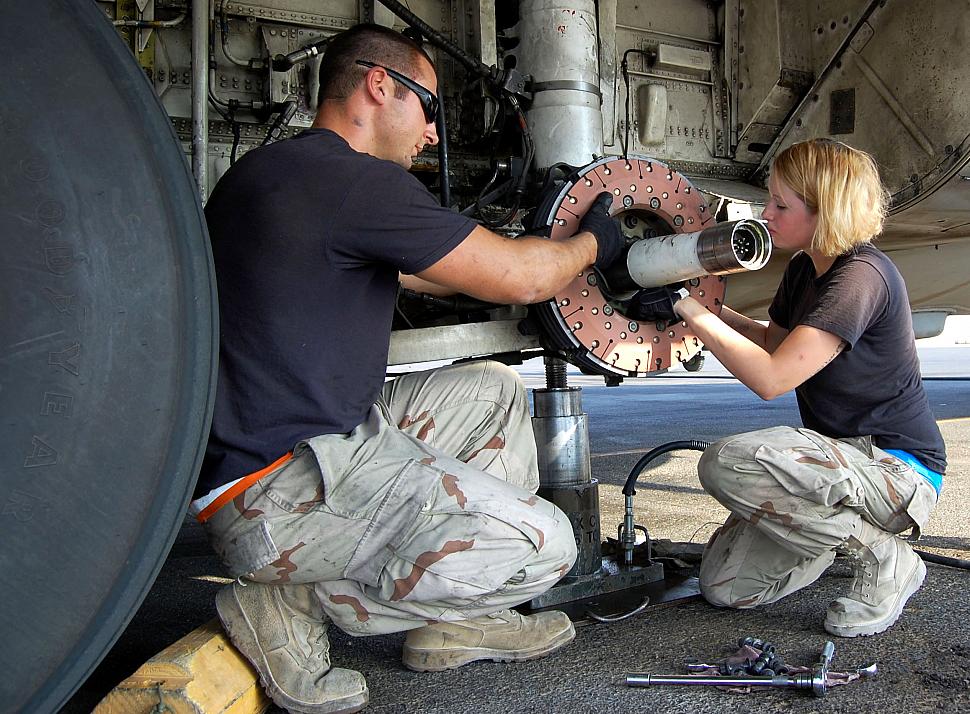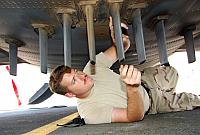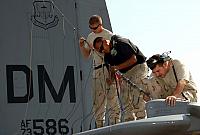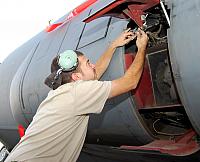C-130 News
C-130 Hercules News
Aging C-130s: the geriatric fleet
November 6, 2007 (by
Staff Sgt. Phillip Butterfield) -
"We are flying our planes into extinction," said Lt. Gen. Gary North.

A perfect example of Airmen working with very old aircraft is at this
forward-deployed location, where the 386th Air Expeditionary Wing's
Expeditionary Maintenance Group is in temporary ownership of some of the oldest C-130 aircraft in the Air Force inventory.
One, affectionately known as "grandpa," was built in 1961 and another was awarded an honorary Purple Heart for sustaining multiple mortar hits and ground fire during the Vietnam War.
Most of the C-130s here were flown during the Vietnam War and now fly in operations Iraqi Freedom and Enduring Freedom.
The base's C-130s accumulate large amounts of flight hours during operations and have undergone different modifications which keep them in the fight. The Airmen performing maintenance on these aging aircraft put in countless hours of work to keep them flying.
"Due to the age of the aircraft we have a lot of electrical problems and cabin pressure problems," said Tech. Sgt. James Vehlies, 386th Expeditionary Aircraft Maintenance Squadron electro-environmental systems craftsman. "Old wires rub together and short out causing system malfunctions and component failures."
Years of system modifications have complicated repairs.
"There are some jobs which take a long time to work," said Senior Airman Michael Sultzer, 386th EAMXS communications and navigation technician. "Due to different modifications the aircraft has had over the years the wiring diagrams get confusing."
As well as being modified over the years, changing the same parts multiple times takes a toll on equipment mounting points.
"Parts stop fitting like they should," said Staff Sgt. Aaron Huffmaster, 386th EAMXS crew chief. "For instance, we had a torque tube used for driving the flaps up and down which needed to be replaced. When we took the plane apart, I noticed the holes had rounded themselves out and now the new part wouldn't fit because the holes were too big. So, a little job has turned
into a big one."
With the apparent challenges the aircraft throw at maintainers, the Airmen are still able to complete the mission with high marks.
"Normally these planes have a 60 to 80 percent mission effectiveness rate ( or MER ) at home," said Master Sgt. Garcia Brown, 386 EAMXS production superintendent. "But, because the maintainers are working so hard, we've been able to maintain a 96 percent MER. I'm proud; they're doing an outstanding job."

Senior Airman Michael Bruke and Airman 1st Class Britney Warner install a multi-disc brake on a C-130E Hercules October 30, 2007 in Southwest Asia. Most C-130s here have been in service since the Vietnam War. Both Airmen are crew chiefs with the 386th Expeditionary Aircraft Maintenance Squadron. [USAF photo by Staff Sgt. Phillip Butterfield]
forward-deployed location, where the 386th Air Expeditionary Wing's
Expeditionary Maintenance Group is in temporary ownership of some of the oldest C-130 aircraft in the Air Force inventory.
One, affectionately known as "grandpa," was built in 1961 and another was awarded an honorary Purple Heart for sustaining multiple mortar hits and ground fire during the Vietnam War.
Most of the C-130s here were flown during the Vietnam War and now fly in operations Iraqi Freedom and Enduring Freedom.
The base's C-130s accumulate large amounts of flight hours during operations and have undergone different modifications which keep them in the fight. The Airmen performing maintenance on these aging aircraft put in countless hours of work to keep them flying.
"Due to the age of the aircraft we have a lot of electrical problems and cabin pressure problems," said Tech. Sgt. James Vehlies, 386th Expeditionary Aircraft Maintenance Squadron electro-environmental systems craftsman. "Old wires rub together and short out causing system malfunctions and component failures."
Years of system modifications have complicated repairs.
"There are some jobs which take a long time to work," said Senior Airman Michael Sultzer, 386th EAMXS communications and navigation technician. "Due to different modifications the aircraft has had over the years the wiring diagrams get confusing."
As well as being modified over the years, changing the same parts multiple times takes a toll on equipment mounting points.
"Parts stop fitting like they should," said Staff Sgt. Aaron Huffmaster, 386th EAMXS crew chief. "For instance, we had a torque tube used for driving the flaps up and down which needed to be replaced. When we took the plane apart, I noticed the holes had rounded themselves out and now the new part wouldn't fit because the holes were too big. So, a little job has turned
into a big one."
With the apparent challenges the aircraft throw at maintainers, the Airmen are still able to complete the mission with high marks.
"Normally these planes have a 60 to 80 percent mission effectiveness rate ( or MER ) at home," said Master Sgt. Garcia Brown, 386 EAMXS production superintendent. "But, because the maintainers are working so hard, we've been able to maintain a 96 percent MER. I'm proud; they're doing an outstanding job."
Related articles:
Forum discussion:
Tags
Forum discussion:
- Start a discussion about this article in the C-130.net forum.
Tags
Additional images:

Senior Airman Christopher Nichols inspects an antenna array on an EC-130 Compass Call for delamination October 30, 2007 in Southwest Asia. Airman Nichols is a communication-navigation specialist with the 386th Expeditionary Aircraft Maintenance Squadron. [USAF photo by Staff Sgt. Phillip Butterfield]

Airman 1st Class Paige Sager, (from left) Senior Airman David Garcia and Tech. Sgt. James Vehlies examine element connectors on a high-power antenna October 30, 2007 in Southwest Asia. The Airmen perform flightline maintenance on EC-130 Compass Call aircraft from the 43rd Expeditionary Electronic Combat Squadron. Airmen Sager and Garcia are crew chiefs, and Sergeant Vehlies is an electro-environmental systems craftsman. [USAF photo by Staff Sgt. Phillip Butterfield]

Tech. Sgt. James Vehlies inspects wires for possible chaffing October 30, 2007 in Southwest Asia. Some of the oldest C-130s in the Air Force fleet fly missions in support of operations Iraqi and Enduring Freedom. Sergeant Vehlies is an electro-environmental systems craftsman with the 43rd Expeditionary Electronic Combat Squadron. [USAF photo by Staff Sgt. Phillip Butterfield]
